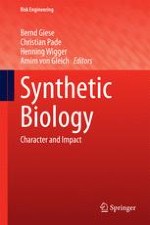2015 | OriginalPaper | Buchkapitel
Hazards, Risks, and Low Hazard Development Paths of Synthetic Biology
verfasst von : Bernd Giese, Arnim von Gleich
Erschienen in: Synthetic Biology
Aktivieren Sie unsere intelligente Suche, um passende Fachinhalte oder Patente zu finden.
Wählen Sie Textabschnitte aus um mit Künstlicher Intelligenz passenden Patente zu finden. powered by
Markieren Sie Textabschnitte, um KI-gestützt weitere passende Inhalte zu finden. powered by
